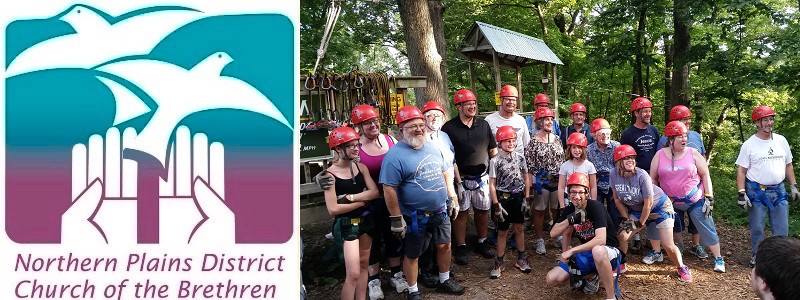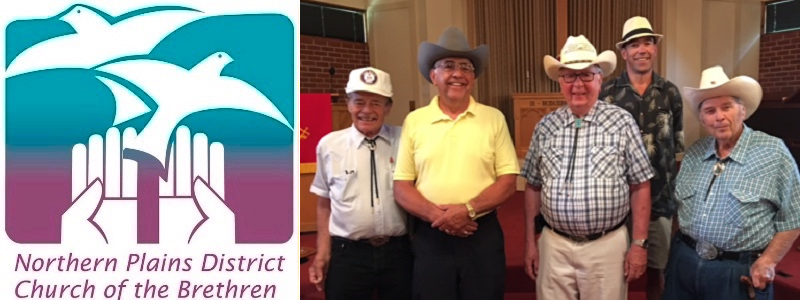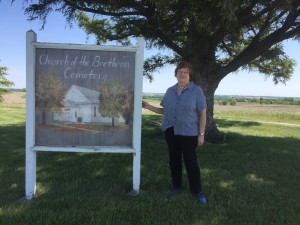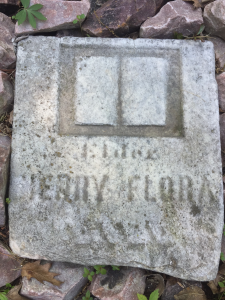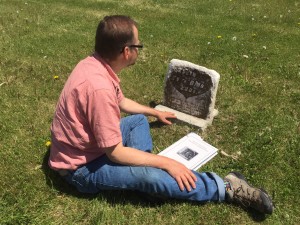From District Conference 2016: Reflections from Past DEs
PAST DISTRICT EXECUTIVES REMEMBER NORTHERN PLAINS YEARS
Northern Plains Brethren held their 150th District Meeting August 5-7, 2016. To recognize this milestone, past District Executives shared memories of their Northern Plains years. Connie Burkholder (1996-2006) spoke at the Friday evening worship. The next day, letters were read from Joe Mason (1995-1996), Tom Bowser (1992-1995), Jim Miller (1985-1992), Charles Lunkley (1977-1984) and Martin Gauby (1972-1976).
Martin Gauby (1972-1976)
The letter from your District Office inviting us to attend your District Conference in Des Moines this coming August was a wonderful offer which I would very much like to accept. However, my health at this time is not good enough to consider our being with you at that time. We will be in prayer for your conference and your District life and work.
As I think back over the four years I was privileged to serve as District Executive for Northern Plains, and the two districts in Missouri and Arkansas, it would be great to speak in person of my gratitude, but let me try to put it in a few words.
The position was not one I had even thought of, but when the invitation came asking if I would consider applying, we accepted that as a door opening, to serve a few years in Edith’s home district.
I remember so vividly the support and encouragement of all the people I had the privilege of working with. We did not always think alike, but we were always on the same team. I had the prayers and support of pastors and District officers. It was a joy to worship in all of the churches, to support pastors, and perhaps give encouragement. I was so lucky, never once having to cancel a meeting.
Our memories, prayers, and best wishes will always be with you. We have fond memories of our years of service to you and the churches of the Northern Plains.
Martin Gauby, 9080 W. Arabian Drive, Boise, ID 83709
Charles Lunkley (1977-1984) from his daughter, Carolyn McDaniel
Thank you for inviting Charles Lunkley to your 150th Celebration. He would love to be there to celebrate with you, however his health is not sufficient to allow him to do that. He remembers with fondness the churches he served both as pastor and district executive. He will be 98, on his birthday, July 2, 2016. He started his full-time ministry at the Prairie city, Iowa, Church of the Brethren in 1947. I am currently writing a book on his and Rozella’s life in the pastorate and mission field, so I have many facts and details in mind. I don’t know when I will finish it, but hope to title it “Movin’ On”, Letters from Africa – a personal true story of a missionary family in the 1950s”.
Dad is virtually blind, with only slight vision in one eye, and he has Parkinson’s disease which limits his abilities considerably. His mind is still sharp and he enjoys her visits from family, friends and caretakers. He also enjoys listening to books on tape. He sends you his greetings with regrets he will not be able to attend. He lives in an assisted care facility owned by our daughter and her husband, just a few miles from me.
Charles Lunkley, 1256 N-400 W., Apt. 3A, Marion, IN 46953-9236
Jim Miller (1985-1992)
There are so many good memories of people, churches, the land, the sky and just the good air and clouds in the various seasons we lived in Northern Plains District. Let me share a couple that stand out:
Our country was experiencing “The Farm Crisis” in the late 1980’s. This was a major issue for our families, communities and churches. It was a challenging time for small towns and rural communities. We saw small businesses, schools, and vital support systems evaporate especially in the rural areas. Through that time, renewed commitment to discipleship and service grew in many of our churches.
I really felt the welcome and support in many of our churches as I would travel throughout the district. There were a number of 1,000 mile week ends with several visits for search committees, worship, district sub committees, etc. Personally, it was an uplifting time in building new relationships and assisting church leaders in their ministry and service.
Creative efforts were found for training pastors. The challenges included long distances, a shift to part time pastors who also had other employment, and integrating ministers new to the Church of the Brethren. However, there was a willingness to work so that solid pastoral training was accomplished. Programs like EFSM, TRIM (with the support of McPherson College) really did make a difference.
I learned to appreciate the warmth and energy of the Northern Plains Brethren. The resources and staffing for the district continued to down size, but the vitality and genius of our life together was strengthened. With the constraints of time and travel, “the district” didn’t do a lot together throughout the year, but the District Conference Weekend, with fellowship, urban rural auction, All District Sunday Worship and the Mon-Dak Family Camp week end, it is impressive what a high percentage of the Brethren in Northern Plains came to these annual events.
To bring you up to date, since I left Northern Plains in 1992, I completed 19 years as District Executive in Shenandoah District, retiring in 2011. Since then, I have kept challenged with volunteer work at the Young Center for Anabaptist and Pietist Studies at Elizabethtown College (PA) and with ESL tutoring in the Harrisonburg VA immigrant communities. Currently, I am interim Pastor at the Mill Creek Church of the Brethren in eastern Rockingham County.
Mary has just retired as an RN with hospice. Before that, she was a floor nurse in a regional hospital and had been a visiting home nurse. This summer we are looking forward to time with our two children’s families, which include four grandchildren! Our daughter Angela is married to Gerhard Hoffmann and they live in Pfullendorf, Germany. They have two children, Benjamin and Katelyn. Our son, Greg, is married to Krista Knicely and they live in Harrisonburg, VA with their two sons, Corbin and Brennan.
Wishing You God’s Richest Blessings.
Jim Miller, 106 Hickory Lane, Bridgewater VA 22812-9555
Tom Bowser (1992-1995)
Let me begin with greetings to the good people of the Northern Plains District. I began service as your District Executive in September 1992 and completed my service in September 1995. I have some good memories of those years, and I have been influenced by some of those events.
One of my goals was to visit every church and every pastor. If my records are correct, I visited almost all of the churches, and I preached twenty times in district congregations. Camping ministries are an essential mission of any COB district, and so I supported both of your camps. Involvement in district board and commissions were important for me as well. And I welcomed the rejuvenation of your disaster ministries following the flooding of 1993.
Although I have never found traveling a hardship, I marveled at the way you viewed distances. Our whole family loves camping, so we drove to Camp Mon-Dak for family camp in July 1993, taking two days each way. Traveling to North Dakota for a regular district board meeting on an overnight bus trip was one of the highlights of my time with you. It struck me how many people from the Mon-Dak area traveled to district board meetings in Iowa, not only without complaint, both with enthusiasm for the work of the district.
Since leaving Iowa, I served as pastor in Nokesville, VA, and served as interim pastor in nine churches in Southern Ohio District, two of which I served twice. I have served on ministry commissions and district boards. I also served as district moderator once. And despite knee and hip surgeries, I have kept involved in the brethren disaster ministry.
One of the gifts of retirement is the opportunity to reflect on past ministries and relationships. I appreciate the chance to remember my time in Northern Plains District. I am sorry Paula and I cannot attend your district conference, but I enjoyed the time I took to think of you. May God continue to bless you as you move forward in faith.
Tom Bowser, 4224 Gorman Ave., Englewood, OH 45322-2623
Joe Mason (1995-1996)
Congratulations to you and your long history of continuous ministry “To the Glory of God and our neighbor’s good” in the Northern Plains region. You’re 150th anniversary is surely a time for celebration with such a long history of continuous ministry. Rejoice and be glad for all the blessings that God has given you.
In September 1995 I gained a very special feel for Northern Plains District of the Church of the Brethren. Five months earlier my wife, Peggy, had died and then later in the summer Karen Miller, Director of District Ministries, asked me to do a one year interim as District Executive in Northern Plains District, foreign territory to me.
After having retired six years earlier from 18 years as a pastor and 22 years as a District Executive it seemed pretty natural to take on that assignment. My years of ministry had been to the eastern part of the US (Virginia, Pennsylvania, Ohio) so venturing west of the Mississippi was an adventure.
In Middle PA and Southern OH where I had served as DE, I could drive to 90% to 95% of the churches in the District within about an hour. Northern Plains is geographically so very different but I soon sensed a kind of closeness, a warm fellowship among the churches and the people that is unique. When you have District Conference it is a real EVENT. You Brethren come together and stay together for several days and enjoy the finest of Brethren fellowship. There was, and I’m sure still is, a genuine sense of Mission over these vast plains.
Stover Memorial Parsonage was graciously prepared as my residence for that year. I’m not sure I did very much during that year, but I did get into most of the churches. Your current DE, Tim, and I even took an all night train trip to Big Sky congregation in Montana for an ordination. I drove every day to the district office in Ankeny where I was frequently visited and given advice and pastoral care by Tim, who was pastor there at that time. My reminiscing could go on and on — you know how it is with old codgers.
Now, however, you are together celebrating the 150th year of Church of the Brethren ministry in the Northern Plains. May you rejoice that “This is our Story” and may you sing with gusto, “This is our Song”, and may you “Continue the work of Jesus, Peacefully, Simply, Together”.
Joe Mason, Timbercrest Community, PO Box 501, North Manchester, IN 46962
Connie Burkholder (1996-2006)
I’m delighted to be with you this weekend for this celebration of the district’s history and faithfulness. I bring you greetings from the Western Plains District and the Monitor COB and all the sisters and brothers there. Thank you for the invitation to celebrate these 150 years with you, and for this chance to share brief reflections on this occasion. Thanks to Tim Button-Harrison and the planning committee for the invitation!
As I reflect on my experience and ministry in Northern Plains, what stays with me is the persistent willingness on the part of so many of you to go to great lengths to be a district, to be in a community of faith over this vast area with scattered churches, and to find ways to be in ministry even when small numbers of people are present. A prime of example of that persistent willingness was the District Board Bus Trips to the Mon-Dak area. We made 3 of those trips during my tenure and I don’t know how many were done before or after that. Every district in the denomination holds their District Board meetings in various locations; but this district is the only district that I know of that has that kind of intentionality and willingness to go those kinds of distances to stay connected as a community, as a body of Christ. This is our story; this is our song of faithfulness.
I know that the District Board Bus Trip is a thing of the past now, but in this time, you are doing other things that show a persistent willingness to go to great lengths to be community together. The division of leadership from one full-time DE to other persons who supplement and complement Tim Button-Harrison’s work shows a willingness to be creative with resources so that connections can be made and ministry can be accomplished. Surely this strengthens the district with gifts and skills of a variety of people being used instead of relying on just one staff person. This is our story; this is our song of faithfulness.
I’m intrigued by another way that I see you being creative in your persistent willingness to be community together and that is in the Sending of the Seventy. What a brilliant way to nurture the relationships in a much broader way than just a DE visiting! This is our story; this is our song of faithfulness.
Another aspect of the persistent willingness to be in ministry as community is through the several churches that are Ecumenical Shared Ministry Churches– where the COB has been paired with another denomination in a shared ministry. These congregations operate a little differently in each circumstance, but in each case the arrangement allows for opportunities for worship, service, outreach, and mutual support in places where Brethren are few in numbers. It takes commitment to relate to one denomination, much less maintaining relationships with two denominations. And yet, that’s exactly what some of you do! This is our story; this is our song of faithfulness.
And then finally a visual aid of persistent willingness to be community together – a T-shirt that, I think, was already in progress when I first came to the district in 1996. As I recall, Lois Hermanson from the Kingsley Church – one of those Ecumenical Shared Ministry congregations at the time – was instrumental in getting this together. On the front are pictures of the church buildings of the district – – as many as she could round up. And you know that means persistence in tracking down people who are willing to provide or take the pictures. And on the back is a map of the District with location and the names of the churches. I wear this T-shirt from time to time. And I do so with fond memories and with joy, because this, too, is our story; this is our song of faithfulness.
I pray that the persistent willingness of this district to be faithful in building community and ministry continues strongly for another 150 years. Congratulations! And God’s blessings to all of you, my brothers and sisters.
Connie Burkholder, 614 North Hartup, McPherson . KS 67460

